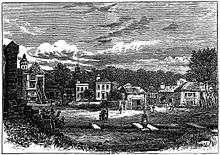Broughton, Edinburgh

Broughton (/ˈbroʊtən/) is an ancient feudal barony, today within the City of Edinburgh, Scotland that was once known for its witchcraft.[1]
Ancient barony
The feudal barony of Broughton in the 16th and 17th centuries was in the hands of the Bellenden family, who had made their money in the legal profession. Sir John Bellenden of Broughton, Knt., (d. October 1, 1576) who was present at the Coronation of King James VI in 1567, possessed the barony of Broughton, with the additional superiorities of the Canongate and North Leith, having therein nearly two thousand vassals, according to Sir John Scott of Scotstarvit, writing in 1754.[2] Broughton passed to his son, Sir Lewis Bellenden, Knt., (d. August 27, 1591) Lord Justice-Clerk and a Lord of Session, who is cited as one of the Ruthven Raiders[3] and ultimately to William Bellenden, 1st Lord Bellenden of Broughton (d. September 6, 1671).[4]
Edinburgh
Scattered houses on the farmlands which originally made up Broughton eventually gave way to more general housing in the century prior to the formation of Edinburgh's New Town which adjoined the parish of Broughton. Its modern borders are defined, approximately, as being Leith Walk in the south east, Broughton Street in the south west, Broughton Road in the north west and McDonald Road in the north east. Moving clockwise from south east, Broughton is bordered by Greenside and Calton, the New Town, Canonmills, and Pilrig.

Broughton's main thoroughfare is Broughton Street. The street has many independent speciality shops.
Broughton is today at the centre of Edinburgh's "pink triangle", an area of the city with a number of gay bars and clubs.
The Broughton Spurtle: Broughton's Independent Stirrer is a community newspaper for Broughton . It has been running since February 1994.
Broughton High School was formerly located in Broughton, but is now located further west in Comely Bank. The Scottish poet Hugh MacDiarmid undertook part of his formal education at Broughton High. Schools still located in Broughton include Drummond Community High School, Broughton Primary School and St Marys RC Primary School.
The Scottish folk band Silly Wizard were based for some time in a flat located at 69 Broughton Street. Phil Cunningham, member of Silly Wizard and younger brother of the band's founder, Johnny Cunningham, still lives in Broughton.
Gayfield Square Police station, which is featured in the Inspector Rebus stories written by Edinburgh-based writer Ian Rankin, is located on Gayfield Square in the south east of Broughton.[5]
Edinburgh's first traffic lights were installed in Broughton Street in 1928.
Gayfield House

Gayfield House is a Category A listed building at 18 East London Street, Edinburgh. Father and son builders Charles and William Butler built Gayfield House between 1761 and 1764 as a stylish country villa combining Scots Palladian with Dutch details and a touch of French decor, within walking distance of the crowded Old Town of Edinburgh. In 1765 the Butlers sold it for £2,000 to Thomas, Lord Erskine (the eldest son of the Earl of Mar who had led the Jacobite rising of 1715) and his wife Lady Charlotte Hope. In 1767, after Lord Erskine's death it was sold to the Earl of Leven. An entry in the Scots Magazine in 1766 states: "Marriage. June 10th. At Gayfield, near Edinburgh, the Earl of Hopetoun to Lady Betty Leven."
A late 18th century print shows Gayfield House standing in attractive grounds, surrounded by fields and by orchards, bounded to the South East by Leith Walk. The fortunes of the house gradually declined in the 19th century as Edinburgh expanded. Loss of garden ground and the ever-approaching tenements around made it less attractive as a private house. In 1873, it was sold to William Williams as Edinburgh's New Veterinary College.[6] This closed in 1904 and it was then bought by a merchant who stored manure in the downstairs rooms. After World War 1 it was used as a laundry which also manufactured ammonia and bleach. In the 1970s it was used as a garage and for car repairs, a hole was opened in its facade and the basement was used as a garage. By 1990 it had fallen into disrepair, was vandalised and much was stolen including carved wood and gesso chimneypieces. A roofer Trevor Harding bought it in 1991, renovated much of it and sub-divided the interior into basement and upper floors. He sold it in 2013.[7][8][9]
Transport
Buses
Lothian Buses
- 8 (Bellevue /Broughton Street)
- 7, 14, 49 (Leith Walk)
- 1, 4, 19, 26, 44 (York Place)
- 10, 11, 12, 16, 22, 25 (Leith Walk /York Place)
Tram
Edinburgh Trams operate services to & from York Place tram stop, near the top of Broughton Street. This is currently the eastern terminus for the route.
| Preceding station | Edinburgh Trams | Following station | ||
|---|---|---|---|---|
| Terminus | York Place - Edinburgh Airport | St Andrew Square towards Airport |
References
- ↑ Grant, J. Old and New Edinburgh, vol. III, Cassell, Edinburgh, 1880s, p. 181
- ↑ Balfour Paul, Sir James, The Scots Peerage, Edinburgh, 1905, vol.ii, p.64/5.
- ↑ Balfour Paul, 1905, p.68-70.
- ↑ Cokayne, G. E., edited by the Hon. Vicary Gibbs & H. Arthur Doubleday, The Complete Peerage, vol. iii, London, 1913, p. 19.
- ↑ "A question of blood and belonging". The Scotsman. 24 September 2004. Retrieved 29 October 2015.
- ↑ The Veterinary Record:27 September 2003
- ↑ Scott, Hamish (16 August 2013). "Beyond the Fringe, the wreck of ages". The Telegraph. Retrieved 29 October 2015.
- ↑ Morris. "Gayfield House - East London Street". Edinburgh Past and Present Historic Houses. Retrieved 29 October 2015.
- ↑ "18 East London Street, Gayfield House Including Boundary Walls and Gatepiers, Edinburgh". British Listed Buildings. Historic Scotland. Retrieved 29 October 2015.
External links
Coordinates: 55°57′28.97″N 3°11′18.19″W / 55.9580472°N 3.1883861°W
